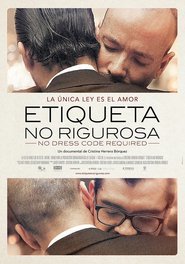We have been looking at LGBTIQ-themed documentaries for Pride Month. We conclude this mini-series with No Dress Code Required, which just played the Human Rights Watch Film Festival.
 Right off the bat, director Cristina Herrera Borquez has a leg-up on other LGBTIQ civil rights documentaries by focusing on a (presumably) little-known fight for marriage equality in the Mexican state of Baja California. Queer stories from this region are not surprisingly few and far between. In No Dress Code Required we follow a gay couple – Victor Fernando Urias Amparo and Victor Manuel Aguirre Espinoza (“The Victors”) – who are withheld from marrying in spite of Mexican law.
Right off the bat, director Cristina Herrera Borquez has a leg-up on other LGBTIQ civil rights documentaries by focusing on a (presumably) little-known fight for marriage equality in the Mexican state of Baja California. Queer stories from this region are not surprisingly few and far between. In No Dress Code Required we follow a gay couple – Victor Fernando Urias Amparo and Victor Manuel Aguirre Espinoza (“The Victors”) – who are withheld from marrying in spite of Mexican law.
What starts as Borquez simply documenting the seemingly minor court case, eventually leads to her having a front row seat in a national media frenzy that shines a necessary light on the dynamics of Mexico’s complicated relationship with the gay rights movement...
Much like Political Animals, which we looked at two weeks ago and which told the story of the lesser-talked about lesbian politicians who have helped steer the political discourse in California towards equality over several decades, No Dress Code Requires shows a part of the LGBTIQ’s global community that has gone significantly underseen. Especially when compared to the actions of white American queer history. Compare this film to, for instance, The Case Against 8 (Manuel's review). That was a story most audiences would have already known, told in relatively bland fashion that only by accident sought to highlight how the LGBTIQ rights narrative was taken over by traditionalist white men and women unlikely to threaten the status quo.
In many ways, the two films have much in common as these two men repeatedly offer the same sort of bland bon mots to the press that read like vetted words from a press release. Their more exciting anger is left for away from the press, Borquez’s camera capturing some of their spiky frustrations spoken in choice words. The film also offers little extra in terms of style, too, but its’ subjects’ backstories are illustrated with chopped-up photography that are a cute visual detour.

While early passages of the film chart the Victors’ stories from childhood to coming out and their first meet at a bar, Dress Code doesn’t get truly interesting until the government interference in their marriage plans begins to spiral into truly gobsmacking territory. A series of progressively ridiculous efforts made to halt their plans include STI testing, multiple visits to an ancient marriage class, and even at one stage a stranger’s letter to the courts insisting the pair suffer from dementia. Some 20 minutes out from the ending, the film's dramatic climax comes with a dog-and-pony show by Baja officials that Borquez and her co-editor Javier Campos Lopez are smart to simply let it play out matter of factly in real time. The absurdity of the scene only escalating with each passing minute.
From these moments, the film loses momentum in the lead up to its inevitable conclusion. Particularly when the key moment of negotiation between the two men and the mayor goes unfilmed (for bureaucratic reasons). Footage of their wedding in front of a large crowd of presumed strangers who have come to use their fight as a civil rights symbol (rather than family and friends) could say something about today’s movement, but anything interpreted by the viewer here is likely just accidental.
The story of No Dress Code Required was new to me, so I appreciated the time spent learning it and the time spent with its charming subjects. It’s not one of the big stories of the last decade of queer rights activism, but it’s an important one nonetheless. It’s not uncommon for documentary filmmakers to stumble into a greater story than they initially had, but I am thankful the cameras were there to capture not just the public side, but the private side, too.